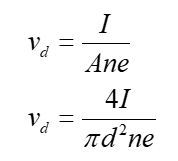A high voltage transmission line of diameter 3.73 cm and length 3.76189 km carries a steady current of 1.9 x103 A. If the conductor is copper with a free charge density of 6 x 1028 electrons/m3, how long (in seconds ) does it take one electron to travel the full length of the cable? (e = 1.6 x 10−19 C).For this problem use scientific/exponential notation to represent your answer. Eg., -0.0001 can be written as 1.0e-4 or as 1.0E-4. Spaces are not allowed.
A high voltage transmission line of diameter 3.73 cm and length 3.76189 km carries a steady current of 1.9 x103 A. If the conductor is copper with a free charge density of 6 x 1028 electrons/m3, how long (in seconds ) does it take one electron to travel the full length of the cable? (e = 1.6 x 10−19 C).For this problem use scientific/exponential notation to represent your answer. Eg., -0.0001 can be written as 1.0e-4 or as 1.0E-4. Spaces are not allowed.
Given data
The diameter of the transmission line is: d = 3.73 cm = 0.0373 m
The length of the transmission line is: L = 3.76189 km = 3761.89 m
The current in the transmission line is: I = 1.9 x 103 A = 1900 A
The free charge density in the copper wire is: n = 6 x 1028 electrons/m3
The magnitude of charge is: 1 e = 1.6 x 10-19 C
The expression for the drift velocity of the electron is given as:

Substitute the value in the above expression.

Step by step
Solved in 2 steps with 4 images









